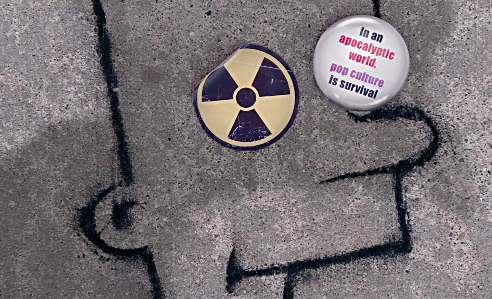Doh! High art and pop art merge in U-M’s head-spinning "Mr. Burns"

Shell-shocked people sit around a campfire discussing a favorite episode of TV series. They try to remember each detail to amuse each other and as a distraction from the problems all around them. The world has been thrown into darkness following a worldwide catastrophic event and stories are all that remain.
This is the premise of Anne Washburn’s Mr. Burns, A Post-Electric Play, opening February 16 at the University of Michigan’s Lydia Mendelssohn Theatre.
“It’s a postmodern play, a pastiche of forms and thematically it goes to the heart of what it means to tell stories, why human beings tell stories,” said Daniel Cantor, the play’s director and head of performance for theater at the university’s School of Music, Theater, and Dance. “Why they need stories, why stories evolve and change across time but have different meanings for people in different contexts.”
Washburn’s play begins soon after the catastrophe. Act II occurs seven years later and Act III occurs 75 years after that. The story they tell and that changes and evolves over time is not from Shakespeare or Chekhov but an episode of The Simpsons called “Cape Feare” (sic). The title is telling in the context, but The Simpson’s episode was a send-up of the 1991 remake of Cape Fear with Robert De Niro and Nick Nolte and the original 1962 film with Robert Mitchum and Gregory Peck, both based on a crime novel by John D. MacDonald.
“What the characters are experiencing at the beginning of the play is something at the back of the minds of all of us right now with the instability of the world and the environment, in that sense it’s topical,” Cantor said. “The play is able to merge pop art and high art in a really interesting way and it’s able to merge really serious things with great humor.”
Despite the grim circumstances, Cantor said they play is a lot of fun and appealing across generational barriers.
“I think part of the reason is, Anne Washburn’s play is about the evolution of storytelling, but also that the stories are really iterations of each other over time and that our stories are referential,” he said, “It was true of the Greeks. Their stories happened 800 years before and passed down orally and then were written down by Homer [appropriately] and then treated theatrically.”

The Greeks based their plays on well-known stories. Many of Shakespeare’s plays were also based on familiar stories. Audiences brought their own references to the stories.
“The Simpsons is one of the most referential art forms that exist,” Cantor said of TV’s longest running comedy. “In many of the episodes of The Simpsons there are literally scores of references, many that go over the audience's heads, to history, culture, and pop culture. All of the writers on The Simpsons were Harvard and Harvard Lampoon guys. They are really smart, highly educated people who made art of being referential.”
Washburn’s play moves from the campfire to a time seven years later, when the survivors around the campfire have formed a touring theater company to present The Simpsons’ “Cape Feare” in a more formal setting. Act III jumps 75 years into the future and Cantor said it has some big surprises for audiences. The act has music and “some distinct choreography” on which Cantor is working with Tzveta Kassabova, a dancer, actor, and professor of movement.
Cantor said his student actors are hip to the offbeat and critically well-regarded play. As The New York Times' theater critic Ben Brantley said, “When was the last time you met a new play that was so smart it made your head spin? Well, get ready to reel ... Anne Washburn’s downright brilliant Mr. Burns, A Post-Electric Play has arrived to leave you dizzy with the scope and dazzle of its ideas.”
“They are really excited about it,” Cantor said. “A lot of them knew about it, they’re theater mavens, so they were excited to be selected.”
He said he and the cast studied such recent catastrophic events as Chernobyl, 9/11, and Katrina to get a sense of the physical and psychological harm.
“The play finds a synthesis between pop art and high art and is appealing to students in that pop culture is taken seriously and it has a postmodern, unconventional form,” he said. “They spin a lot of plates.”
Hugh Gallagher has written theater and film reviews over a 40-year newspaper career and was most recently managing editor of the Observer & Eccentric Newspapers in suburban Detroit.
"Mr. Burns, A Post-Electric Play" will be performed at the Lydia Mendelssohn Theatre in the Michigan League Building on the central U-M campus at 7:30 pm on February 16, 8 pm on February 17 and 18, and 2 pm on February 19. For tickets, phone -734-764-2538, visit tickets.music.umich.edu or go in person to the League Ticket Office at Fletcher Street and North University Avenue, 9 am to 5 pm Monday-Friday and 10 am to 1 pm on Saturday.


































